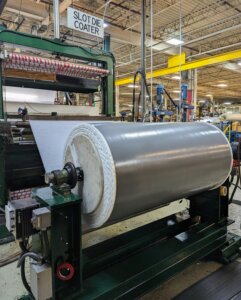The Slot Coater and What It Can Do For You
If you’re looking into the idea of a slot coater, perhaps you’re considering the scalability of your business. Or, you’re simply curious. No matter what, we have a primer ready for you. Take a look at the slot die coating process, slot coaters, extrusion coating, and what they all have to do with each other.
What is slot die coating used for?
Before you explore the slot die coater further, we recommend familiarizing yourself with its uses. A slot die coater is a machine many rely upon without fully understanding its precise purpose. At its most basic level, we use the slot die coater to deposit thin layers of film—and perhaps most importantly, consistently.
Typically speaking, you’ll use slot die coating machines to apply liquid chemistries (in other words, solutions) to substrates.
What kinds of substrates? While the types of substrates associated with this process can vary, you’ll most often see it related to glass, polymers, and metals. Keep in mind, not all of the chemistries deposited with slot die coaters have the same consistency. A slot coater can just as easily work with a slurry as it does a thin solution, as well as an extruded thin film.
Quite often, you’ll see a process in which we dissolve the desired coating in a thin solution or slurry ahead of time. We then utilize the machine to deposit the liquid onto a substrate using a device known as a “slot die” or “slot die head”. The slot die is a precise coating head, distributing the amount you want in the location you want without variation. Not only is the production precise—it’s also continuous. Remember, as your business grows, speed and efficiency will become more important. So many business owners, however, feel that they must choose between quality and scalability. The slot coater essentially solves this problem.
What is the benefit of using a slot coater?
As you can imagine, there is a huge demand for these thin films in many different industries. The priority in these industries often becomes scalability—that is, getting the same results (a high quality, correctly made product) at a higher production rate. We ultimately put emphasis on speed, consistency, and efficiency. On multiple levels, a slot coater provides these results.
Some of the benefits of using a slot coater include:
- Less product waste. Other coating methods often require using more solution or slurry than you need. This means you have an unused amount of excess coating. The slot die coating process is more precise, as it’s “pre-metered”. A pre-metered machine prevents waste, and the closed system incorporated into it also prevents contamination. In the end, you waste less product, which means you also waste less money. Reducing waste is an important part of saving money.
- Increased speeds. As previously mentioned, scalability depends heavily on increased production speed. A slot coater has a positive displacement pump, which applies a constant stream of solution or slurry onto a substrate. The slot die itself allows you to alter the chemistry of the solution if necessary, which cuts down on the amount of workload put on drying units. The process quickens in more ways than one.
- Control of cross-web distribution. To put it simply, this means that the slot die support system has just as much importance as the slot die. The system ensures that you can position the slot die relative to the substrate, ensuring better control. Furthermore, this system encourages heat control as well. When we control heat, we also control fluid viscosity, ultimately promoting better uniformity.
- Better weight control. Because the system ensures a constant delivery of fluid, it’s easier for us to regulate the pumping rate in relation to the line speed ratio.
Remember, if affordability and efficiency is a particular concern for your business—consider a third party manufacturer. Contract manufacturing exists as a great way for you to outsource your production without losing involvement. You’re provided with results from a reliable third party, and you don’t have to invest in your own equipment, or for that matter your own permanent employees.
How does extrusion coating work?
Let’s examine the process of extrusion coating. You’ll hear this in relation to slot die coating, but there are some specific details you should be aware of.
Extrusion relies on extruding resin from a slot die. In this case, the slot die can reach up to 320 degrees Celsius during the process, and we extrude the resin directly onto a moving web. The web passes through a nip, which itself consists of a rubber covered pressure roller and a chrome plated cooling roller. During the extrusion coating process, the molten film cools back into a solid state, creating the demanded finish on a plastic surface. It creates the desired thickness by working with a web that moves much faster than the speed at which the resin extrudes from the die.
What kinds of products do we make with extrusion coating? So many! The industry utilizes this process to create photographic film, mill and industrial packaging, flexible packaging, sack linings, transport packaging, building, envelopes, release base, and medical or hygiene packaging, as well as liquid packaging.
As you can see, there are many different avenues to explore when it comes to coating.
Fortunately, you can get whatever answers you need from CTI. Give us a call at 419-924-5566 or contact us here. We’ll walk you through any questions you might have about coating. We might even be able to find some solutions for you!
- << < Previous Post
- 1
- 2
- ...
- 28
- ...
- 241
- 242 Next Post > >>


